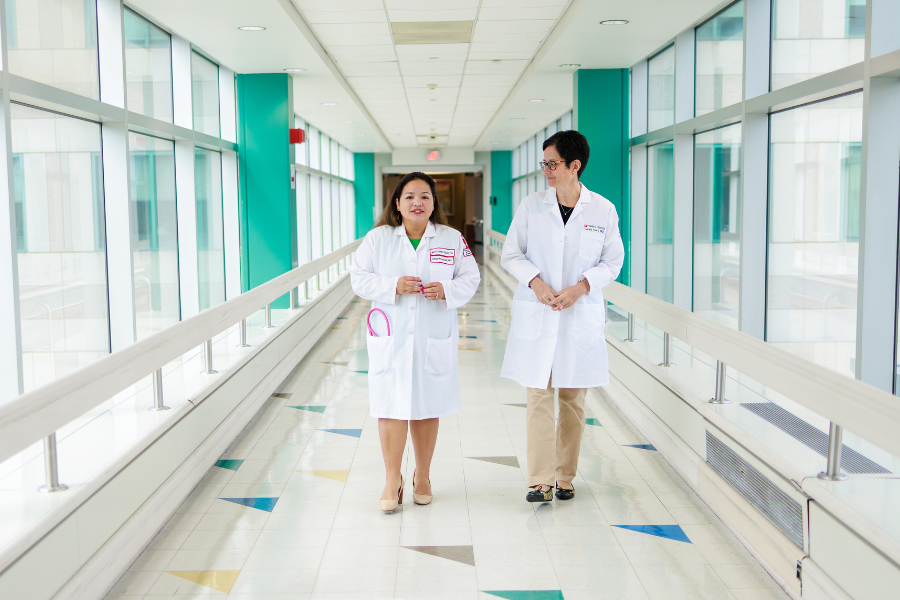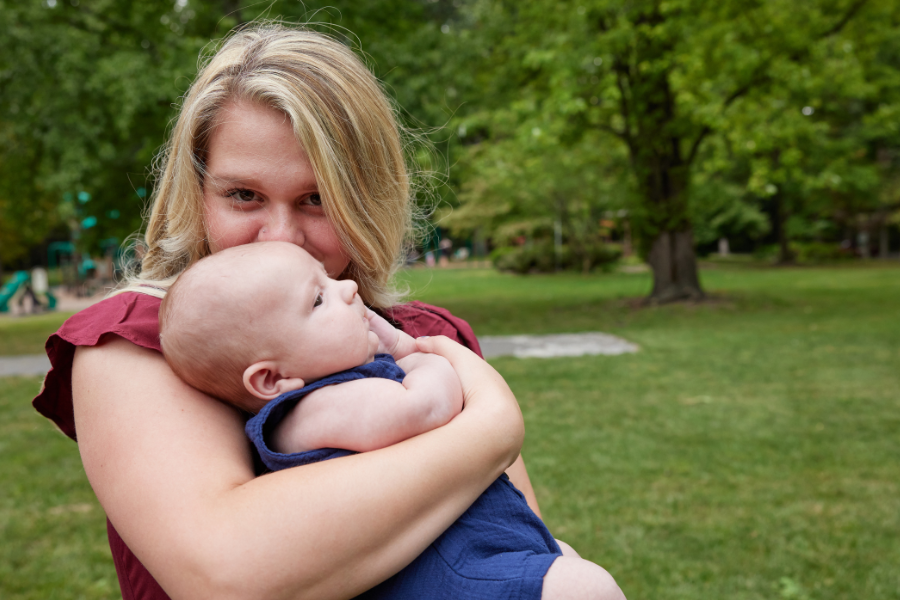These Philly Doctors Are Making Pregnancy Safer When Mortality Rates Are Reaching Highs Locally and Nationally

It’s an alarming statistic, but infant and maternal mortality is on the rise in the U.S., a country that already has unusually high rates for a developed nation.
Dr. Laura Hart, a perinatologist, and Dr. Estefania Oliveros, a cardiologist, both at Temple Health, serve on the Philadelphia Maternal Mortality Review Committee, which pulls together health experts across the city to make recommendations on combatting Philly’s particularly severe maternal mortality rates. Through that role, they’ve seen firsthand what’s driving the problem in Philly. A higher rate of conditions linked to cardiovascular disease, such as obesity, as well as a lack of access to adequate or advanced care – factors that correlate with high poverty rates in the city – in part make Philly’s population more at risk.
“A third of pregnancy-related deaths are linked to cardiovascular disease. As a cardiologist, it makes you examine yourself and see what you can do,” Oliveros says. “These are often young parents who do not have access to care, or access to a care team that listens and recognizes the problem and can react–the signs and symptoms of a cardiovascular issue can be very subtle and can be dismissed.”
Those barriers to adequate care can make all the difference. When you’re dealing with a complex health condition during pregnancy, you’re immediately on the clock–the patient has to get in the best condition possible in under nine months at the most.
“You have 40 weeks to make an impact, and before that you have to line up all your tasks for the first and second trimester to assure that you have a good maternal and fetal outcome,” Oliveros says.
Knowing that these patients need advanced treatment as quickly as possible, Oliveros and Hart looked for a solution, and found it in each other. Together, they’ve partnered on a Cardio Obstetrics program at Temple Health, which brings together two different departments (Cardiology and Maternal Fetal Medicine) to improve access to mult-disciplinary care and decrease rates of maternal mortality due to cardiovascular disease and conditions.
How they’ve managed to work together, and the knowledge that they’ve acquired while doing so, presents a lifesaving solution for not just patients and health care in Philadelphia, but pregnant people seeking help across the U.S.
Confidence and Skill to Connect the Dots
Hart and Oliveros point to one major reason that cardiovascular care systems can stop short of successfully helping a pregnant patient–until the past few years, cardiac care providers often had little training or education regarding pregnant patients.
“Many physicians outside of obstetrics panic when they see pregnant patients,” Hart says. According to Oliveros, just surveying the literature on pregnant patients in cardiology journals, you can see limited research on the issue.
“Five years ago, there was nothing coming out from the American College of Cardiology or the American Heart Association,” Oliveros says. “Maternal-fetal medicine is a different world, and it’s been a little more siloed, with just the occasional input from cardiology.”
When Hart needed a cardiologist for a patient, however, Oliveros was consistently there–and from that experience, they had an idea.
Because time and experience is critical in treating cardiac conditions in pregnant patients, they could form a unique program that would pull in physicians from across the obstetrics and cardiac departments–the aptly named Cardio Obstetrics program.
The program brings together members from across multiple departments, from anesthesiologists to cardiology subspecialists to genetic counselors to maternal fetal medicine specialists, to improve care across the board for pregnant patients. One of the program’s strengths is its ability to streamline communication between two disciplines.
Due to this communication, the team is able to triage at-risk patients, reducing time to treatment by a critical amount: Patients that may have waited for a few months for an appointment were now being seen within one week of referral.
“With earlier treatment for the baby and the mom–you can really make an impact,” Oliveros says.
Care Through the Big Day and Beyond
Because the cardiac team is able to follow the patient from the moment they come in, they’re better able to monitor cardiac health through to the big day, indicators of which can change dramatically during a pregnancy. On the other hand, because the obstetrics team has become more familiar with how cardiologists like Oliveros think, they’re better able to quickly identify potential conditions that are developing in the pregnant patient, and use their preexisting channels to get the relevant team members involved.
“One of the exciting elements is that the more you start getting into the weeds of it, the more you see, the more expertise you generate as a group,” Hart says. In other words, instead of just a fusion of disciplines, Cardio Obstetrics has become a form of expertise in itself.
This allows the team to better tailor care around the patient. In other health systems, a patient who has a cardiac condition is usually transferred to the cardiac unit, and suddenly they’re being treated by a whole new set of doctors. In the Cardio Obstetrics program, the patient delivers on Labor and Delivery and the cardiology team comes to the patient. The team is equipped to provide advanced treatment without separating mom and baby, which makes this major life event closer to what the parent may have envisioned.
“There’s evidence out there of improved outcomes when we can keep the patient and baby together,” Hart says. “There’s an actual biological benefit.”
A Focused Effort
Beyond the standard benefits, the way the Cardio Obstetrics program instills a personalized approach in the whole team can help identify and address all the hard-to-catch warning signs that can present during pregnancy. One of the program’s patients, a nursing student named Jennifer, experienced this firsthand. Despite being physically fit, she experienced extreme shortness of breath after her second child. When she sought help locally in Central Pennsylvania, she was repeatedly told by her cardiologists that she was fine, even that she just needed to “go back to the gym” to get in shape.
“I was thinking to myself, ‘Am I crazy?’ I’ve had multiple doctors tell me that there was nothing wrong with me, but deep down, I knew I didn’t feel well,” she says.
When she became pregnant with her third child, her anxiety grew, so she looked for help from Temple’s Cardiac Obstetrics program after reading about physicians there online.
Dr. Oliveros took up her case, and immediately began running a series of tests; she confirmed Jennifer’s suspicions, but told her through careful monitoring, she would be okay to give birth.
“It was the first time I felt like I was heard,” Jennifer says. Because Jennifer lived two hours away in York, she got as much of the testing done as possible while at Temple, and supplemented it with some remote care. Oliveros kept in contact with Jennifer throughout the process.
She ultimately gave birth at a hospital in York, and even from a distance, Oliveros was there to help. Hours after her child was born, Jennifer began experiencing severe symptoms–headaches and high blood pressure. She went back to the hospital for help, but “the ER doctor was kind of lost and didn’t know what to do.”
Jennifer called Oliveros that night, and she diagnosed her from afar with preeclampsia. The ER lacked the capability to treat her, so she was transferred to Temple, where she was given the appropriate medication and treatment.

Jennifer with baby Braxton today; after Temple’s Cardio Obstetrics program identified diagnoses of preeclampsia and peripartum cardiomyopathy, and provided treatment and support for a safer pregnancy.
“They saved my life,” Jennifer says.
Even after care, the Cardio Obstetrics team isn’t done. They build in time to care for patients during what some call the Fourth Trimester, or the postpartum period where the parent’s and child’s health are still being shaped. In addition to advice on lifestyle, they offer genetic counseling services as part of their program. Jennifer, for example, had a strong family history of cardiac conditions that had an underlying genetic cause. Thanks to a treatment plan designed to keep her cholesterol down, she can live a healthier life, as well as look out for her three healthy children. She’s planning on going back to school–and becoming a cardiac nurse.
“I’ve been through so much with my son and myself that it would be nice to relate to patients on a personal level and help encourage and coach them,” she says.
Oliveros and Hart might be happy to hear that–one of their major goals for the program is to pass on the knowledge they’ve acquired through collaboration as a new standard for younger physicians and medical staff.
“The more expertise we gain in the area,” says Oliveros. “The more we can provide to our trainees, fellows, residents–we’re trying to train the next generation so that they know how to handle the problem from the start.”
This is a paid partnership between Temple Health and Philadelphia Magazine